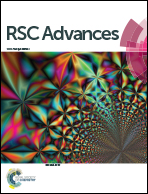Plasma enhanced label-free immunoassay for alpha-fetoprotein based on a U-bend fiber-optic LSPR biosensor†
Abstract
A simple, label-free and cost-effective localized surface plasmon resonance (LSPR) immunosensing method was developed for detection of alpha-fetoprotein (AFP). The U-bend fiber optic probe was firstly pretreated by microwave-induced H2O/Ar plasma to ensure better silanization, which could greatly improve the adsorbed amounts and uniformity of the gold nanoparticles (GNPs) on the fiber optic probe surface. Furthermore, according to the sucrose refractive index (RI) testing result, the absorbance sensitivity to RI change of this sensor was obviously improved due to the plasma pretreatment. Finally, on the basis of this U-bend strategy and plasma pretreated method, the fabricated biosensor displayed good analytical performance for detection of AFP, ranged from 5 to 200 ng mL−1 in both phosphate-buffered saline (PBS) and human serum, with different detection limits of 0.85 and 3.3 ng mL−1 respectively. Therefore, the present strategy definitely paves a way for wider applications of LSPR in clinical research and may eventually become a promising technique for protein detection.


 Please wait while we load your content...
Please wait while we load your content...